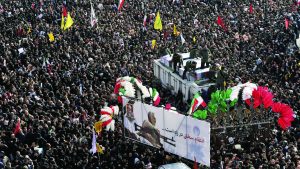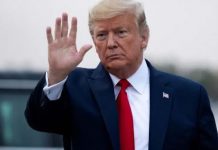 The West Asian region, the Middle-East for the Western world, is on the boil with the US and Iran targeting for a few months each other’s interests in Iraq, where the two have widespread presence. The US precision drone strike near Baghdad international airport, killing Iran’s key military general, Quds Force commander Major-General Qassem Soleimani, described by the Americans as a “terrorist”, has added a new dimension to the escalating tensions between the US and Iran.
The West Asian region, the Middle-East for the Western world, is on the boil with the US and Iran targeting for a few months each other’s interests in Iraq, where the two have widespread presence. The US precision drone strike near Baghdad international airport, killing Iran’s key military general, Quds Force commander Major-General Qassem Soleimani, described by the Americans as a “terrorist”, has added a new dimension to the escalating tensions between the US and Iran.
Iranian Ambassador to the United Nations Majid Takht Ravanchi has termed Suleimani’s killing an “act of war on the part of the United States”. The slain general looked after Iran’s Revolutionary Guard Corps’ foreign operations arm. The US did not stop here. Again, on January 4, a fresh airstrike hit pro-Iran fighters in Iraq as fears grew of a proxy war erupting between Washington and Tehran a day after an American drone strike killed Gen Suleimani.
On January 5, as Iran warned of military action against US interests, calling President Donald Trump a “terrorist in a suit, Trump said, “Let this serve as a warning that if Iran strikes any Americans, or American assets, we have targeted 52 Iranian sites (representing the 52 American hostages taken by Iran many years ago), some at a very high level and important to Iran and the Iranian culture, and those targets, and Iran itself, will be hit very fast and very hard. The US wants no more threats.”
The two sides have already been targeting each other’s interests for the past few months after they together with Iraqi forces and some foreign troops, eliminated the Islamic State (IS) of Syria and the Levant. Interestingly, the US helped the war against the IS with its superior air power. Once the IS was silenced, the US and Iran got fully involved in protecting their own regional interests. The US along with Saudi Arabia did all they could by spending billions of dollars to bring about regime change in Syria, but could not be successful in overthrowing the pro-Iran Basher Al-Assad regime. The survival of Assad is considered a victory for Iran, which has been spending liberally on its proxy fighters.
In the war for regional dominance between Iran and Saudi Arabia with the help of the US, Teheran has been on the side of the mostly Shia rulers in the region — the governments in Iraq and Syria. Qatar, though a Sunni Muslim monarchy, joined the Iranian camp after it faced serious differences with Saudi Arabia on various regional issues. Iran has been behaving more aggressively after it succeeded in saving the Assad regime in Syria.
Some other factors have also started working in its favour for some time. If it has Qatar, the world’s richest country, on its side, Teheran is also being helped by Turkey directly or indirectly. Iran and Turkey, despite their denominational differences, are found on the same platform when it comes to criticising the US and Israeli role in West Asia.
Despite all this, Saudi Arabia remains the dominant force in the region. But it faces a serious threat from Iran and its allies and, therefore, it does not hesitate in seeking the help of the US, its most powerful Western ally. The Saudis will not shed even a tear if Iran is under attack from the US and its regional allies like Israel. The suspected attack by Iran-promoted militias on the Saudi oil infrastructure last September and sabotage of tankers in the Gulf in May and June should be viewed against this backdrop.
For a few months Iran has been engaged in a proxy war through the militias its sustains. Pro-Iran militias attacked Iraqis hosting US and its allies’ forces two months back. This was followed by a major rocket attack near Kirkuk in which a US citizen, a contractor, was killed.
The US, obviously, was not going to keep quiet. Soon it struck five sites in Iraq and Syria associated with the Kataib Hizbollah, an Iran-funded militia. As a result, the Iranians went wild and torched the US Embassy compound in Baghdad.
This forced the US to deploy hundreds of additional troops to take care of its interests in the Middle-East and launch a precision drone attack in Baghdad resulting in the death of Iranian Revolutionary Guard Corps’ senior general Suleimani. Another top Iranian military man and Suleimani’s number two, Abu Mahdi al-Muhandis, was also eliminated in the drone strike.
This was enough for the US to increase its military presence in the region. Washington deployed 750 additional soldiers besides its 5,200 troops in Iraq. Last year, the US brought 14000 troops to be stationed in West Asia to ensure that the interests of Washington as also those of its allies remain unharmed. Besides these, the US has decided to station between 3000 and 3500 troops in Quwait.
Before the US attack on the Saddam Hussein regime in Iraq in 2003, the Iranian position in the region was not as strong as it is today. Iraq under Saddam, militarily the most powerful country in the region then, had fought an eight-year-long war with Iran. That enemy number one of Iran was eliminated by another top enemy of Teheran.
After Saddam became history the government formed in Baghdad was more attracted towards Iran than to the US. That is why when the first elected government was formed in Baghdad, the first country the then Iraqi President visited was Iran. The two countries even now are closest to each other.
The US military presence in Iraq with a clearly demarcated green zone has not been able to prevent the Iraqi government from maintaining very cordial ties with Iran, Washington’s sworn enemy. It is difficult to find a bigger policy failure than that of the US in Iraq. The US spent billions of dollars and lost many well-trained soldiers in the Iraqi war theatre, yet it could not capture Iraq.
Now if there is a war between the US and Iran in the region, it will be difficult for Iraq to be on the side of the US as the Iraqi public, excepting Sunnis, is fully pro-Iran. Most of the people in the entire Middle-East will be on the side of Iran in such an eventuality. The governments in Saudi Arabia and other US allies in the region will be with the US, but the public in these countries cannot be expected to behave as their governments would.
Thus, the US policy in the region has not helped its regional allies as much as it did in the case of Iran, obviously indirectly. This is one reason why the US will think twice or thrice before taking any military action again Iran.
letters@tehelka.com













